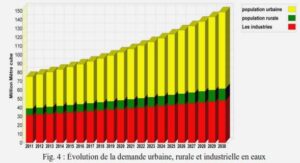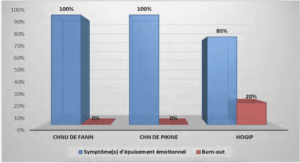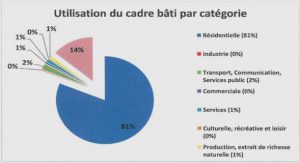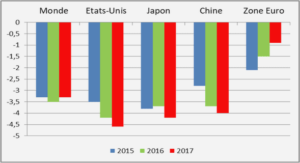Télécharger le fichier original (Mémoire de fin d’études)
Nucleoid organization
Genomic DNA supports information that encodes an organism and as such must be easily accessible for essential DNA-related proteins that replicate, repair or transcribe it. Surprisingly, this accessibility of DNA occurs even though DNA forms a compact structure known as chromatin, or nucleoid in bacteria. Each human nucleus, which measures on average about 6 µm in diameter, contains around 2 m of de-compacted DNA, and the unwound DNA of a bacterium like Caulobacter crescentus measures 1.3 mm, compacted into a 2 µm long cell. In a bacterium like E. coli, it is reported that the nucleoid occupies ~75% of the whole cell volume (Fisher et al. 2013). Thus, the DNA must fit into this restricted space, while remaining accessible for DNA replication (which will double the amount of DNA in the same cell) and subsequent segregation into each daughter cell.
Overall, not much is known on D. radiodurans nucleoid organization and the processes underlying chromosome segregation. Thus, the next section will describe the current state-of-the-art on nucleoid organization and chromosome segregation in model bacteria, in order to fully apprehend the differences with D. radiodurans. For the sake of clarity, we will explore the organization of the nucleoid and its segregation independently.
As we will see, the organization of the nucleoid can be analyzed at different levels. We will adopt a bottom-up point of view, starting from the molecular level, then the micro and macrodomains level, in order to finish with the global spatial configuration level of the nucleoid. There is a strong interplay between these different levels of organization and all of them contribute to the compaction and architecture of the nucleoid. Moreover, as it will be clear throughout the review of the literature, DNA segregation and its organization are intimately linked.
Molecular organization by nucleoid-associated proteins
At the molecular level, biochemical factors play an important role in the compaction and organization of the nucleoid. Bacteria produce small, but abundant proteins that associate with the nucleoid (NAPs, nucleoid-associated-proteins). The study of their molecular roles on the compaction and dynamics of DNA has suffered from some of their properties. Indeed, NAPs are redundant and pleiotropic, which complicates in vivo studies. Moreover, these biological challenges are also worsened by the technical challenge posed by the small size of bacterial nucleoids (<1 µm). Indeed, it hinders the usability of conventional microscopy techniques (see paragraph “II.5 Optical resolution principle”). Nevertheless, numerous NAPs have been identified and characterized in different bacteria.
The nature and number of NAPs are not conserved across different bacterial species (Table 1.1). NAPs can play the role of transcription factors and even impact transcription, replication, and recombination (Dillon & Dorman 2010). In the following, we will briefly summarize the properties of common NAPs such as the small basic ones (HU, IHF, Fis, NH-S) and SMC, a larger one. They are found scattered throughout the nucleoid (Wang et al. 2011) and can have a broad range of effects on the chromosome; if we focus on the topological consequences, three main categories can be drawn: (i) the bending of DNA, (ii) the connection of distant regions and (iii) the coating of DNA strands (Figure 1.5). Interestingly, as we will see, NAPs can belong to multiple categories. More details can be read in these general reviews on nucleoid organization (Badrinarayanan et al. 2015; Surovtsev & Jacobs-Wagner 2018) or in the NAP focused review (Dillon & Dorman 2010).
(i) Among the NAPs that induce sharp DNA bending are the Fis protein (factor for inversion stimulation), the IHF protein (integration host factor) and the HU protein (Heat unstable). This bending can dramatically change the topology of the DNA and can promote the formation of loops. The HU protein is a small, basic, protein (10 kDa, usually composed of 90 to 99 amino acids (Grove 2011)) that resembles eukaryotic Histone H2B while being present and highly conserved in all bacteria. E. coli mutant strains lacking HU have a perturbed cell division, resulting in poor growth and some anucleate cells (Huisman et al. 1989). In E. coli, HU has also been proposed to play a role in DNA repair, by reducing the formation of double strand breaks generated by ionizing radiation that occur when lesions are induced in both strands within a distance of a few base pairs (Hashimoto et al. 2003). HU and IHF share some sequence similarities and both bind non-specifically to DNA and are composed of two subunits that interact with the minor groove of the DNA duplex to induce its bending. HU also displays high affinity for specific DNA structures including nicks, gaps, junctions and forks (Balandina et al. 2002).
(ii) Distant regions of the chromosome can be connected through the action of H-NS (histone-like nucleoid-structuring). This connection can occur for example by bridging into a loop different regions that can span several kilobases. The bridging of DNA by H-NS has been proposed to actually constrain its negative supercoiling by isolating looped regions of DNA. Recently, HU has also been reported to promote long-range contacts in the chromosome, in the megabase range (Lioy et al. 2018).
(iii) H-NS has also been shown to coat the DNA, which can alter its rigidity. The H-NS is a molecule capable of oligomerization, which spreads on the DNA and can directly occlude different binding sites of the DNA, thereby interfering with transcription, leading to gene expression regulation. At high concentrations, HU heterodimers form rigid filaments in vitro where HU and DNA spiral around each other (Luijsterburg et al. 2006). Interestingly, HU possesses a higher affinity for
All the NAPs presented in this section are small basic proteins (10-20 kDa). The SMC complex (structural maintenance of chromosomes) is generally also considered as a NAP and yet it is much larger than previously presented NAPs (>150 kDa) and is analogous to eukaryotic condensins or cohesins. The SMC complex forms a ring-like structure, which can modify the chromosome topology, by encircling the DNA, like a handcuff. It appears that distant regions of the chromosome can be connected through the action of the SMC complex. It is made of an ATPase and two regulatory proteins, named, ScpA and ScpB. In E. coli, analogous proteins MukB, MukE, MukF, form the related complex MukBEF.
It is noteworthy that the different NAPs presented above are not as equally abundant in cells. Moreover, in E. coli their levels of expression vary during the cell cycle.
Figure 1.5: Representation of the different activities of HU, IHF, Fis, H-NS and SMC NAPs. HU proteins (in green) can bend or wrap DNA around itself. SMC proteins (in cyan) can form a ring structure that handcuffs the DNA. H-NS (in blue) dimer of dimers can bridge DNA. IHF proteins (in red) can induce U-turn bends to DNA. Fis proteins (in orange) also bend the DNA. From (Badrinarayanan et al. 2015).
Compared to model bacteria, D. radiodurans possesses very few NAPs and some display different properties (see Table 1.1). For example, D. radiodurans lacks Fis, H-NS and IHF proteins. SMC proteins also do not appear to play a major role in nucleoid condensation in D. radiodurans (La Tour et al. 2009). The major NAP that organizes D. radiodurans nucleoid is HU (Passot et al. 2015; Toueille et al. 2012). Its action is facilitated by the DNA gyrase that modulates the extent of supercoiling of the DNA. Both HU and DNA gyrase have been shown to be essential for D. radiodurans viability, and the progressive depletion of HU leads to nucleoid decondensation. Interestingly, only one HU protein is produced by D. radiodurans unlike D. deserti (another Deinococcus species) that produces three variants of HU, DdHU1, DdHU2 and DdHU3 (La Tour et al. 2015). The presence of either DdHU1 or DdHU2 is sufficient for survival. These two HU genes can even substitute the sole HU gene in D. radiodurans unlike DdHU3.
Table des matières
Table of Contents
Table of Figures
Table of Tables
Table of Abbreviations and Acronyms
Chapter I: Introduction
1. Deinococcus radiodurans
1.1. Overview
1.2. Cell wall structure
2. Nucleoid organization
2.1. Molecular organization by nucleoid-associated proteins
2.2. Micro- & macro-domain organization
2.3. Spatial organization of the nucleoid
2.4. Nucleoid compaction mechanisms
2.5. D. radiodurans chromosome organization and condensation
3. Chromosome segregation
3.1. ParABS system, an active model for origin segregation
3.2. Passive model for bulk chromosome segregation
3.3. Segregation termination
3.4. Segregation in D. radiodurans
4. Bacterial cell division
4.1. Rod vs. (ovo)cocci division
4.2. Division site selection and cytokinesis
4.3. D. radiodurans cell division
Chapter II: Overview of fluorescence microscopy
1. Optical microscopy
2. History of fluorescence microscopy
3. Fluorescence
4. Fluorophores
5. Optical resolution principle
6. Conventional fluorescence microscopy
7. SR fluorescence microscopy
7.1. Ensemble
7.2. Single-molecule
Chapter III: Objectives of the PhD
1. Autoblinking: a SR artifact
2. D. radiodurans cell and nucleoid dynamics
3. Dissemination
Chapter IV: Autoblinking
Chapter V: D. radiodurans cell and nucleoid dynamics
1. Abstract
2. Introduction
3. Results
4. Discussion
5. Methods
6. References
7. Supplementary material
Chapter VI: Discussion and perspectives
1. Autoblinking
2. D. radiodurans cell and nucleoid dynamics
2.1. Cell morphology definition
2.2. Cell growth
2.3. Nucleoid organization, segregation and compaction
2.4. Perspectives
3. D. radiodurans imaging
Chapter VII: Appendices
1. Codes used for analyses
1.1. Density graph of foci
1.2. Perimeter fraction of a phase 1 diad
1.3. Translation of trackmate output to trackart input
2. Video material
3. Résumé de la thèse en Français
Bibliography
Acknowledgment
Resumé
Summary
Télécharger le rapport complet




